Affiliate links on Android Authority may earn us a commission. Learn more.
Nexus 6P vs iPhone 6S Plus
Published onNovember 6, 2015
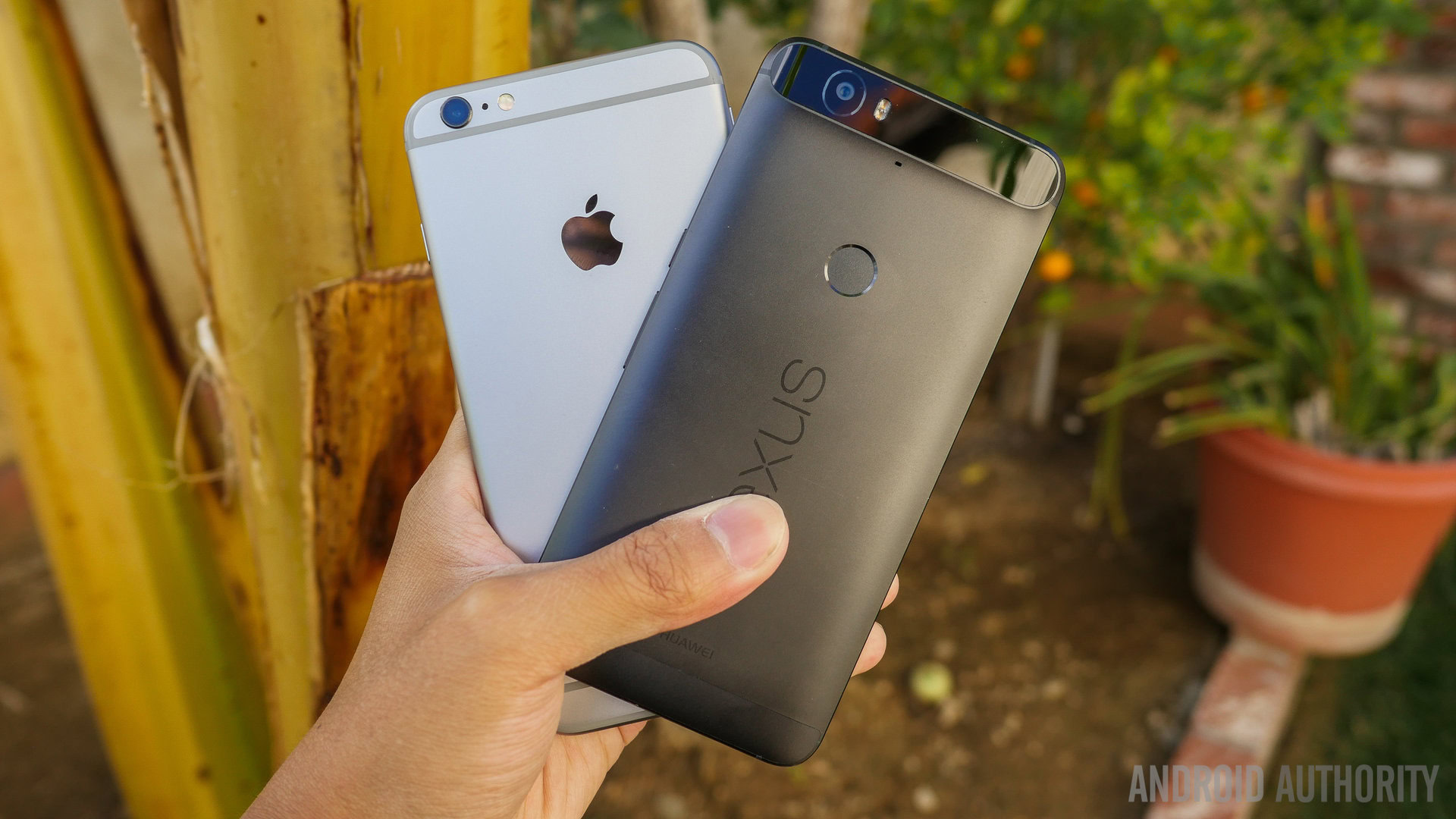
Google decided to take its Nexus smartphone line down a new path with the Nexus 6, a premium device that unfortunately featured a price tag to match its quality. Continuing on that path, the Nexus 6P is the most premium Nexus device yet, and comes at a lower price tag than its predecessor.
In the other camp is the latest large display smartphone from Apple. Even though this is an “S” year for the series, this device strays for the standard formula by bringing to the table some new and useful additions and upgrades. How does these large display flagships compare? We find out, in this comprehensive look at the Nexus 6P vs iPhone 6S Plus!
Design
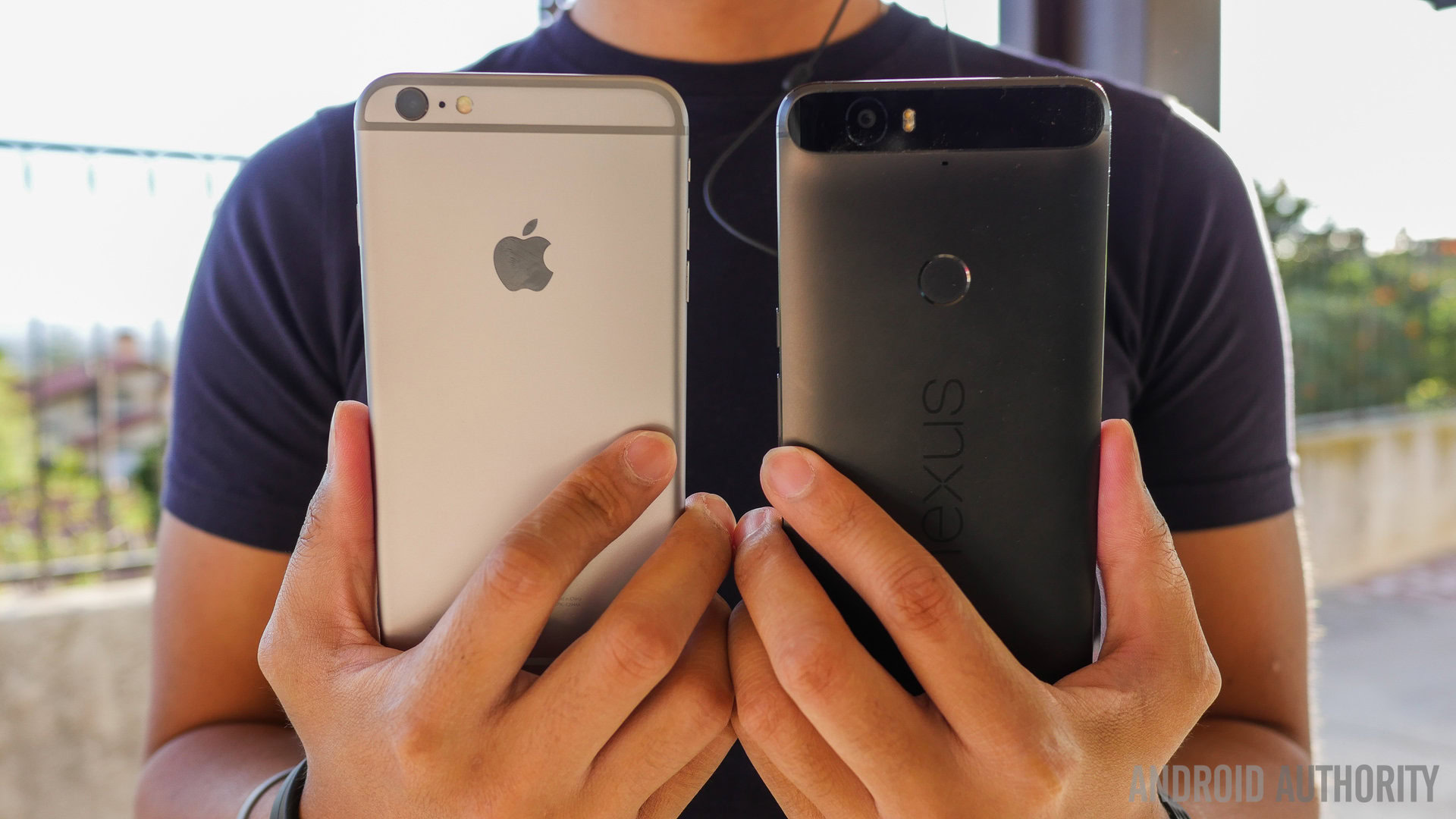
As far as the design is concerned, its clear that metal is the order of the day with both smartphones.
The iPhone 6S Plus, as the name suggests, is the larger of Apple’s two new smartphones of this year, and given that it is an “S” iteration, it’s not surprising that the design language of its predecessor has been retained, bringing back the metal unibody construction seen with last year’s iPhone 6. Rounded sides and corners keep the phone feeling really smooth in the hand, maybe too much so however, resulting in a somewhat slippery handling experience, which isn’t great news for a device with a large display.
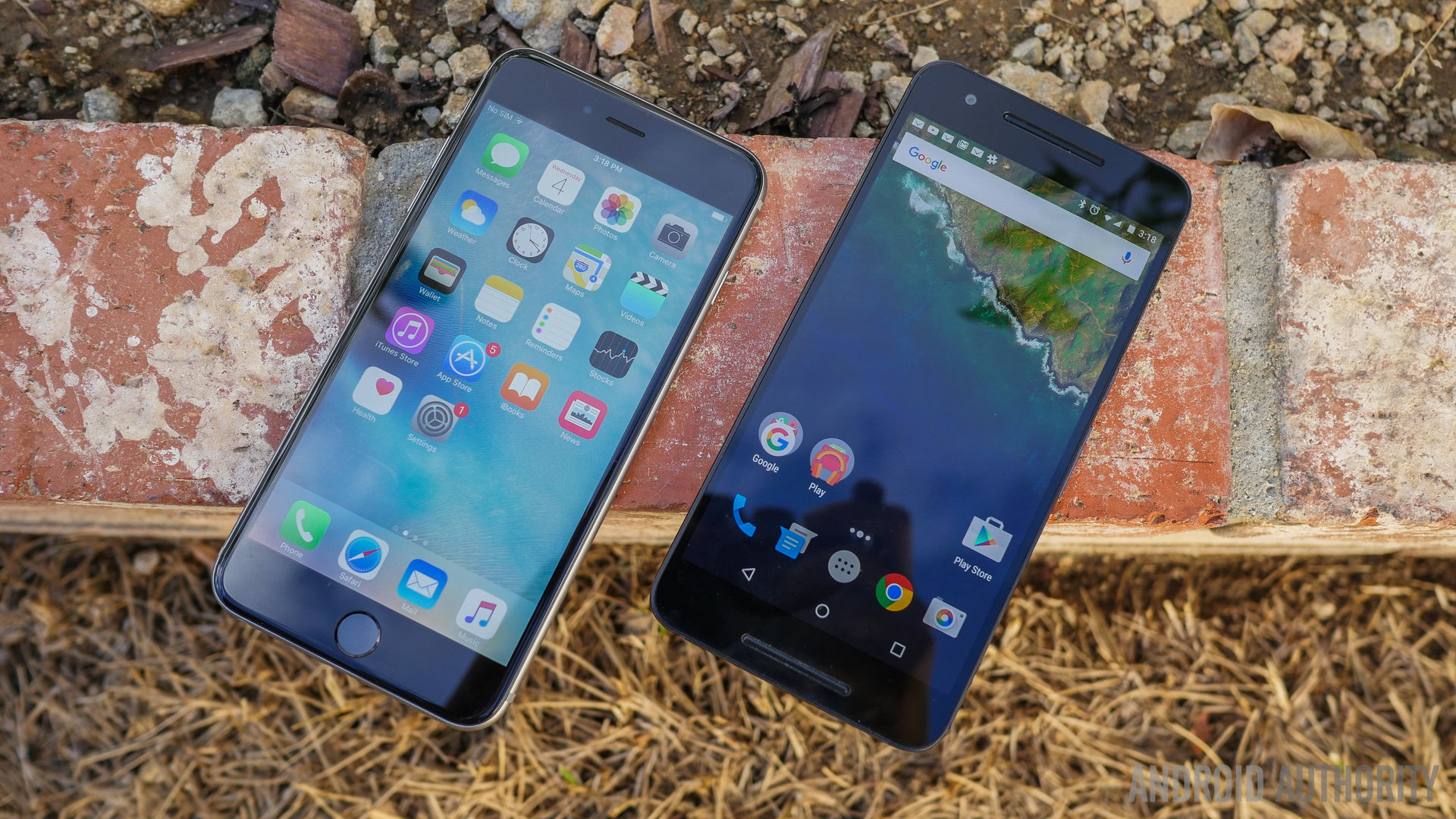
2.5D glass adorns the front, with the signature home button the only real blemish to be seen here, once again featuring an embedded fingerprint scanner. The sides retain the classic layout as well, with the volume rocker under the silence toggle, and at the bottom is the Lightning port, flanked by the single speaker and the headphone jack. On the back, the only clear lines on the phone outline a rectangle in the middle, and there is also the protruding camera at the top left corner.
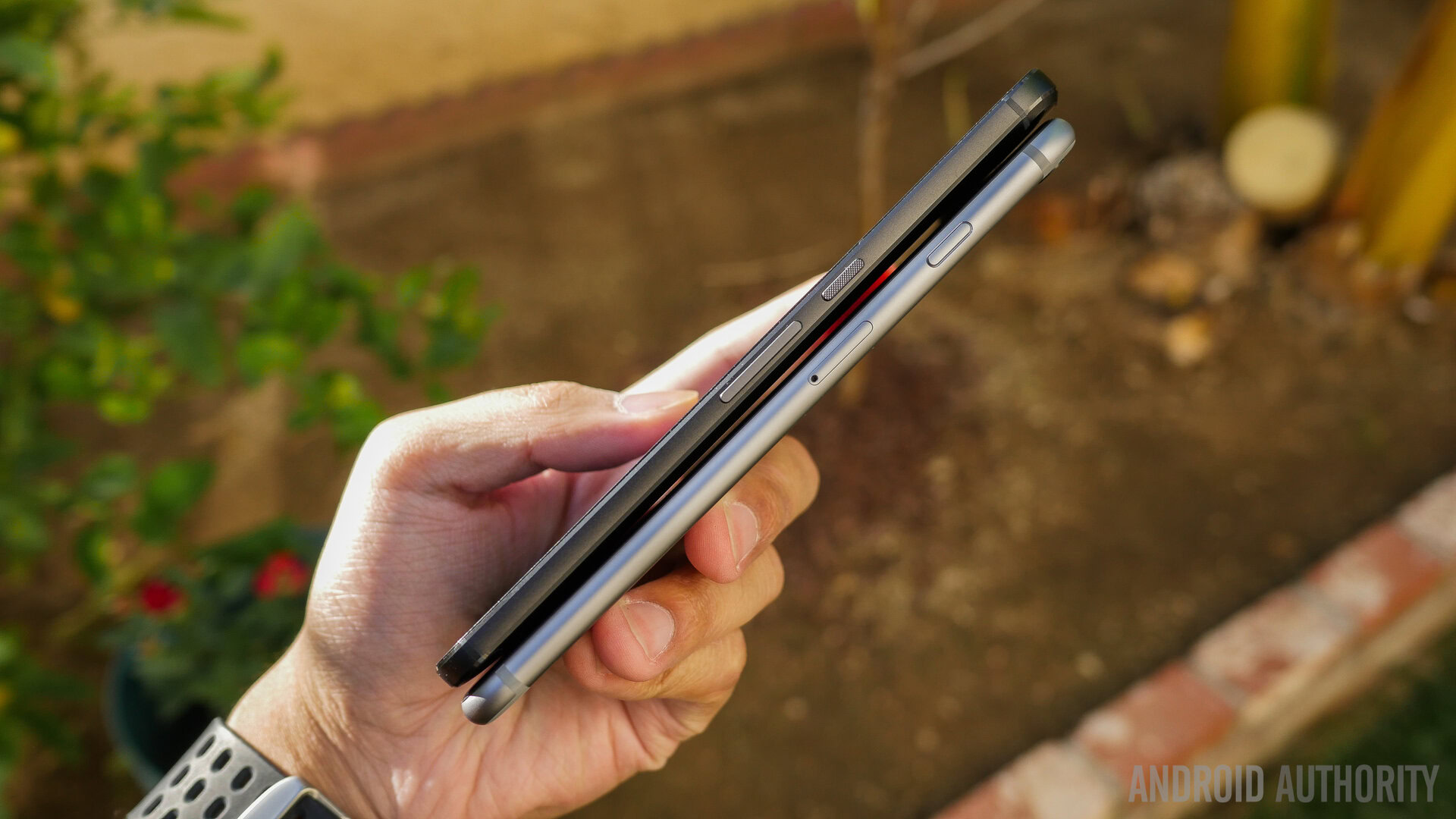
On the other hand, the Nexus 6P features a big departure from the way Nexus smartphones have been constructed in the past. While Nexus manufacturers have tended to borrow design cues from their own flagship offerings, things are a little different this year. With HUAWEI at the helm, there has been a distinct re-imagining of what a premium Nexus smartphone should be.
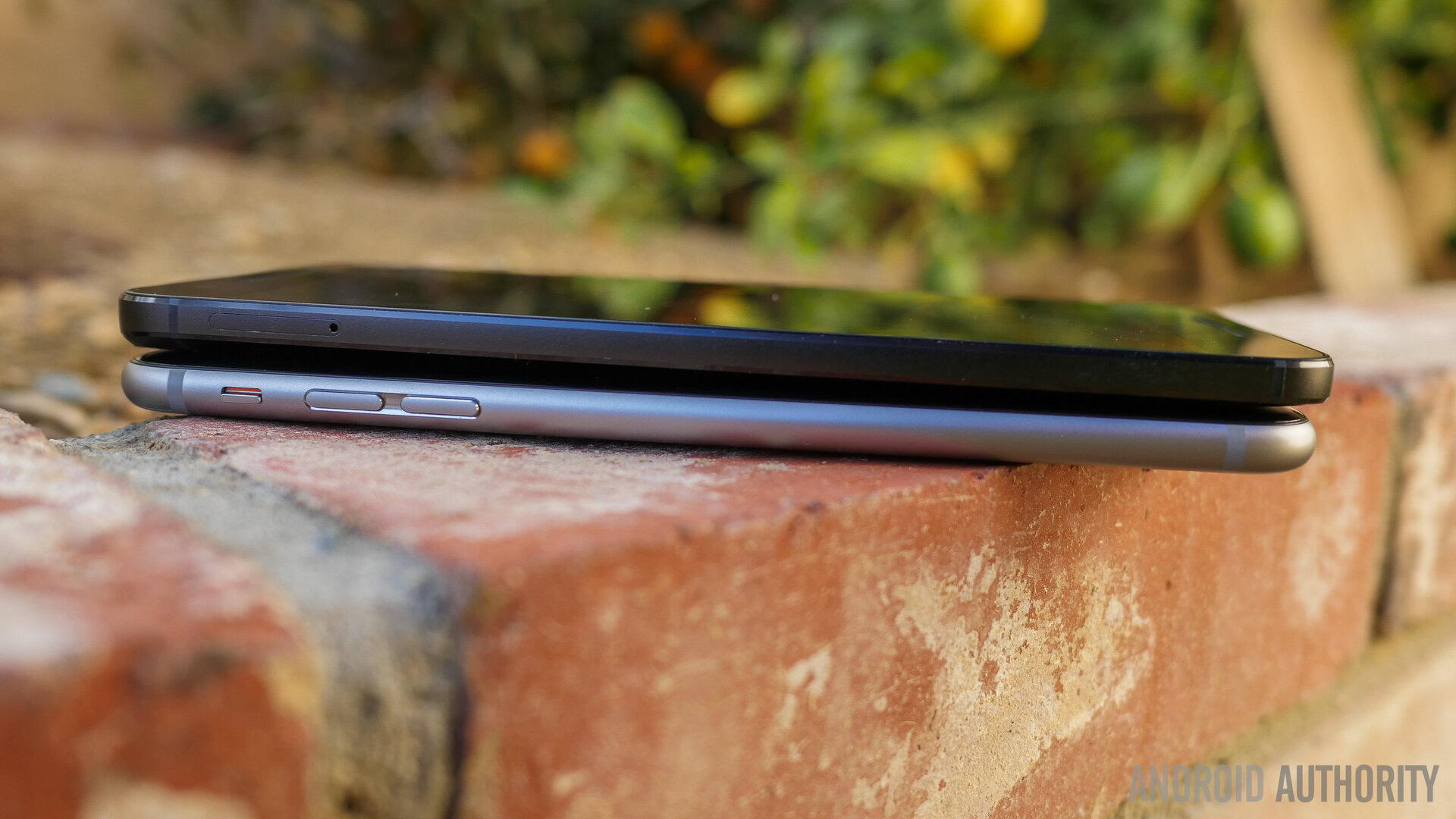
Metal encompasses a more boxy design, with the flat sides contributing to the handling experience. The volume rocker and power button are all placed on the right side, with the latter placed to be within easy reach and featuring a textured pattern to make it easy to locate by feel. The front face of the device is dominated by the large display, and there is not much else to be found here, save for the front-facing camera, and the dual speaker setup. The headphone jack is up top, and at the bottom is the USB Type-C port, that brings a new standard to the world of Android.
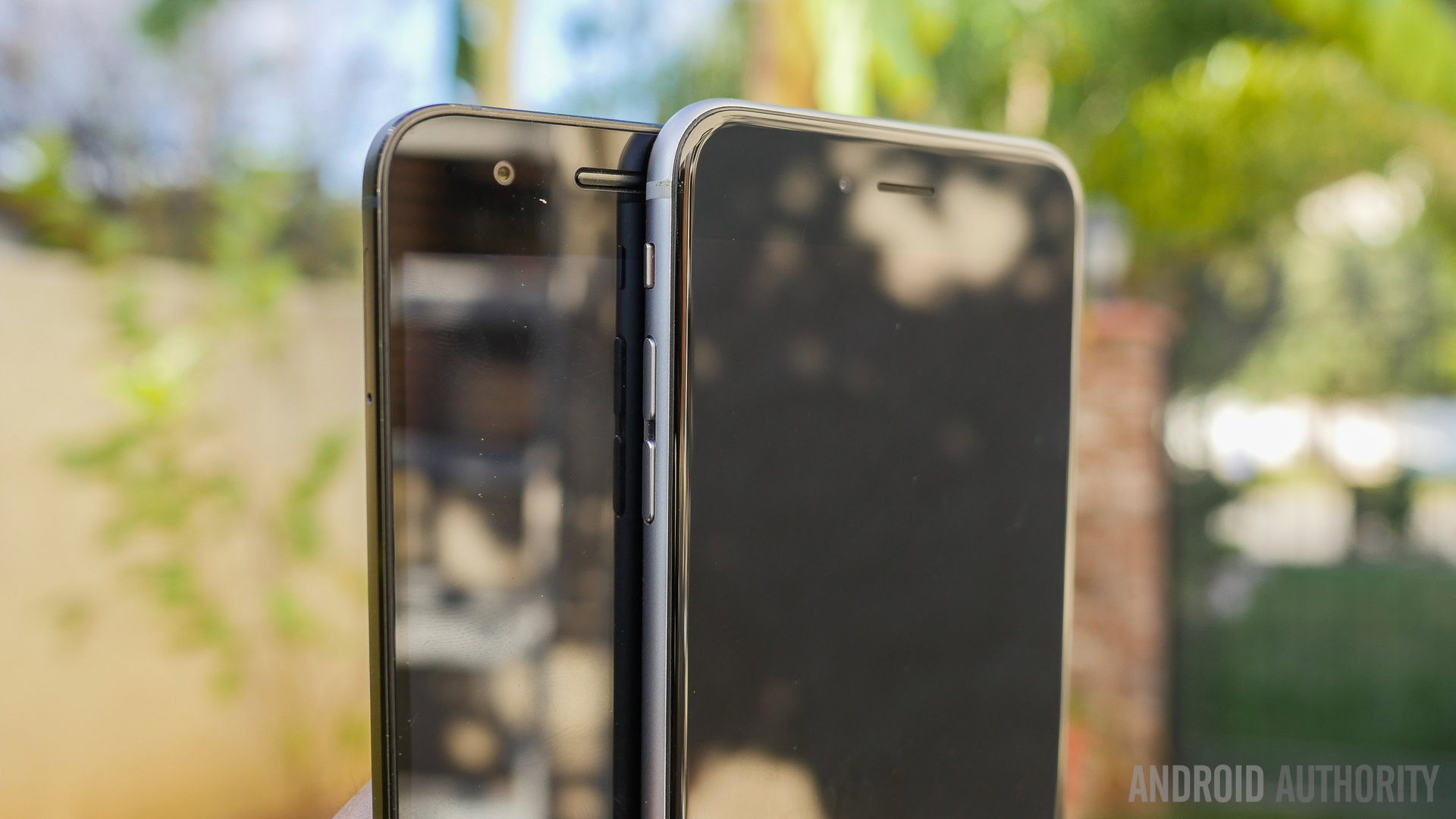
On the back is where the unique design element is to be found, with the black bar up top that houses the camera package. It might look a little odd, but it certainly grows on you, and looks much better than what the initial press renders may have suggested. If nothing else, it serves the purpose of keeping the camera physically protected. On the back is also where you will find the new fingerprint reader, powered by Nexus Imprint, in the middle, placed within comfortable reach of your index finger.
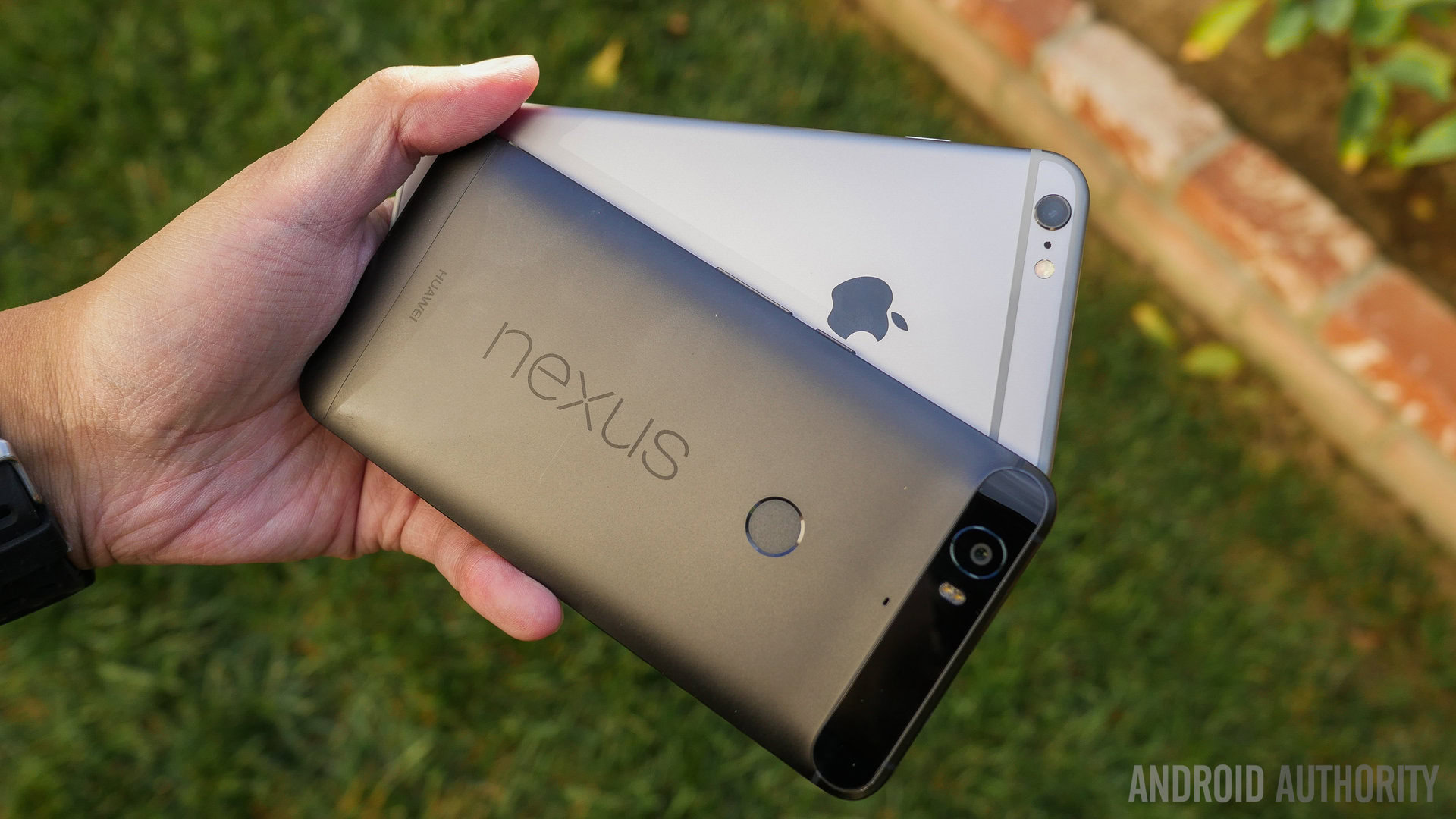
Deciding between these two designs is obviously a matter of personal choice, but the choice can be pretty easy when looking at such different devices. The iPhone 6S Plus feels like the sleeker of the two, but the Nexus 6P takes the series to new premium heights with a sturdy feel and industrial look. While both smartphones do look great, it is worth mentioning here that while the iPhone 6S Plus is simply a much larger version of its flagship counterpart, the Nexus 6P stands alone, with only the plastic clad Nexus 5X as its smaller alternative.
Display
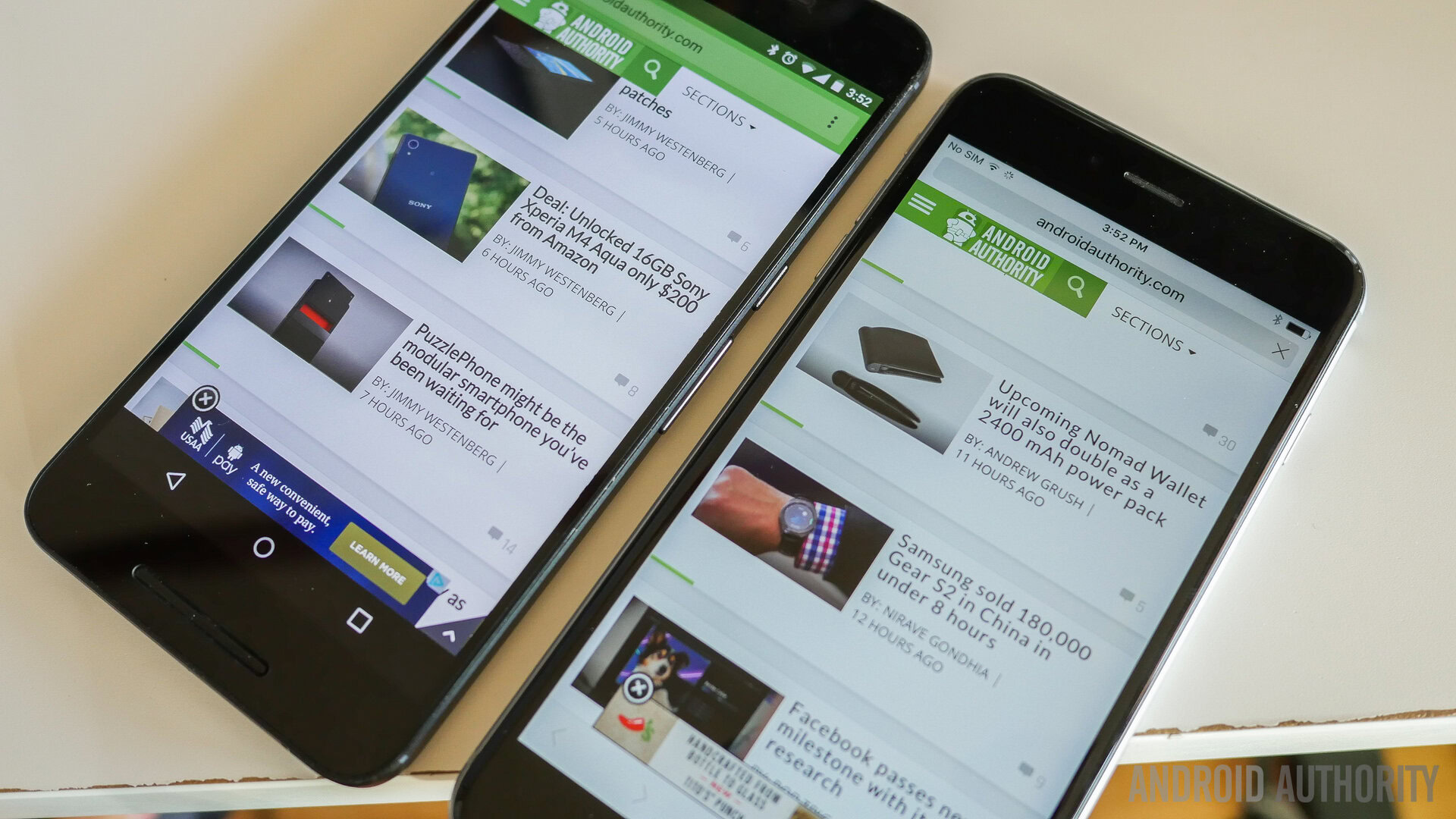
Displays on these two devices brought higher resolutions than what were found in previous iterations, even if Apple still doesn’t try to match up to the standards currently set by the Android powerhouses.
The iPhone 6S Plus features a 5.5-inch IPS LCD display with a Full HD resolution, resulting in a pixel density of 401 ppi. 1080p was a development that wasn’t made available to Apple users until the arrival of the Plus line, but the company has always done a good job with their displays, regardless of their comparatively lower resolutions. Colors are nice and vivid, and the translucent effects in iOS help showcase how well the IPS display can perform. Brightness is of no concern either, even if it has to be pumped up to the highest level in daylight for optimal viewing, and while sharpness might be slightly lacking in comparison, reading text is of no issue on this Full HD screen.
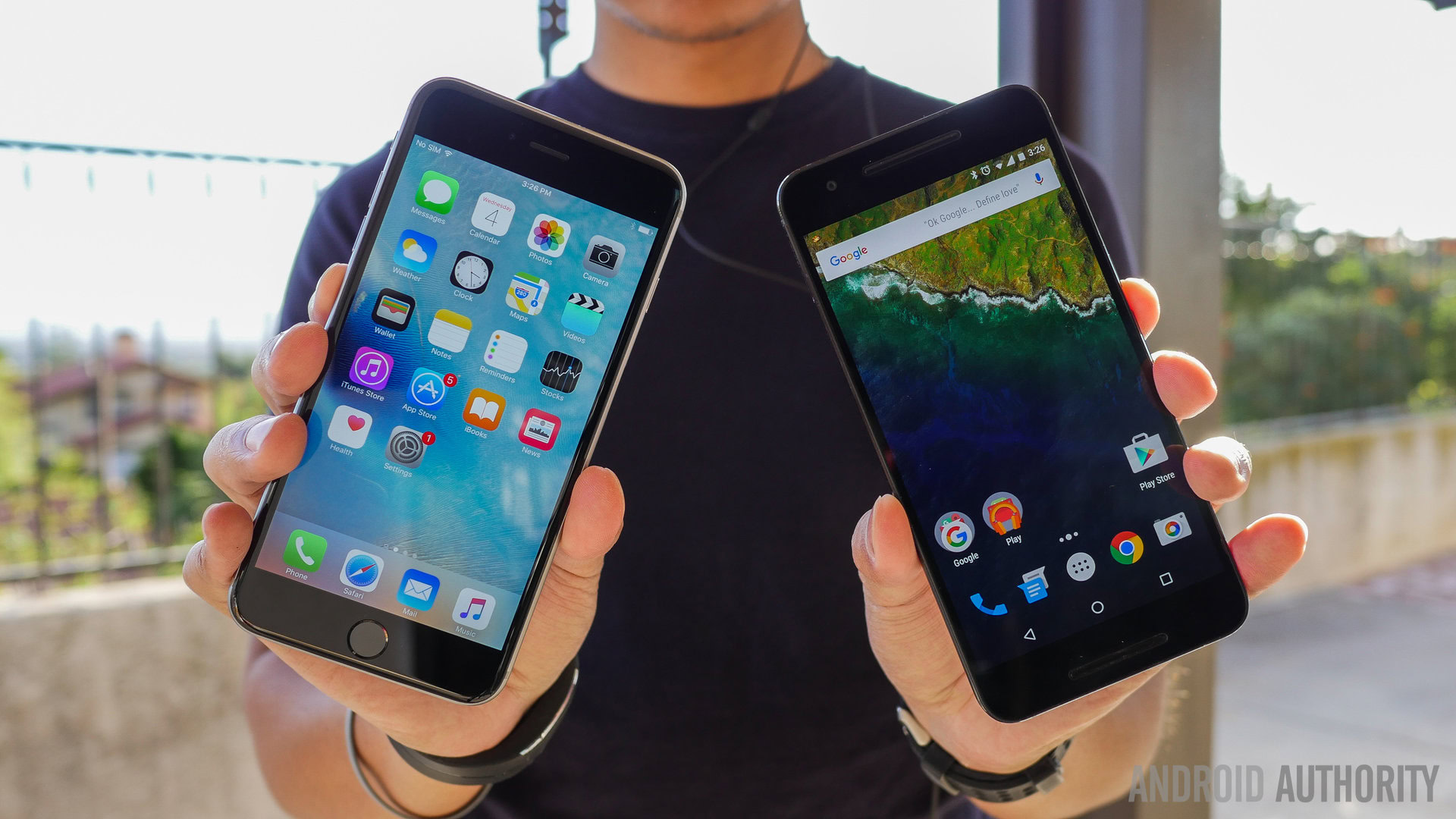
1080p is a thing of the past when looking at the latest and greatest in the world of Android however, with Quad HD becoming the accepted flagship standard. The 5.7-inch AMOLED display of the Nexus 6P features a 2560 x 1440 resolution, resulting in a pixel density of 518 ppi. AMOLED is always a good choice if you’re looking for deep blacks and high contrast, that really make the colors pop. The high resolution makes everything from media to text look great, with everything as sharp as ever.
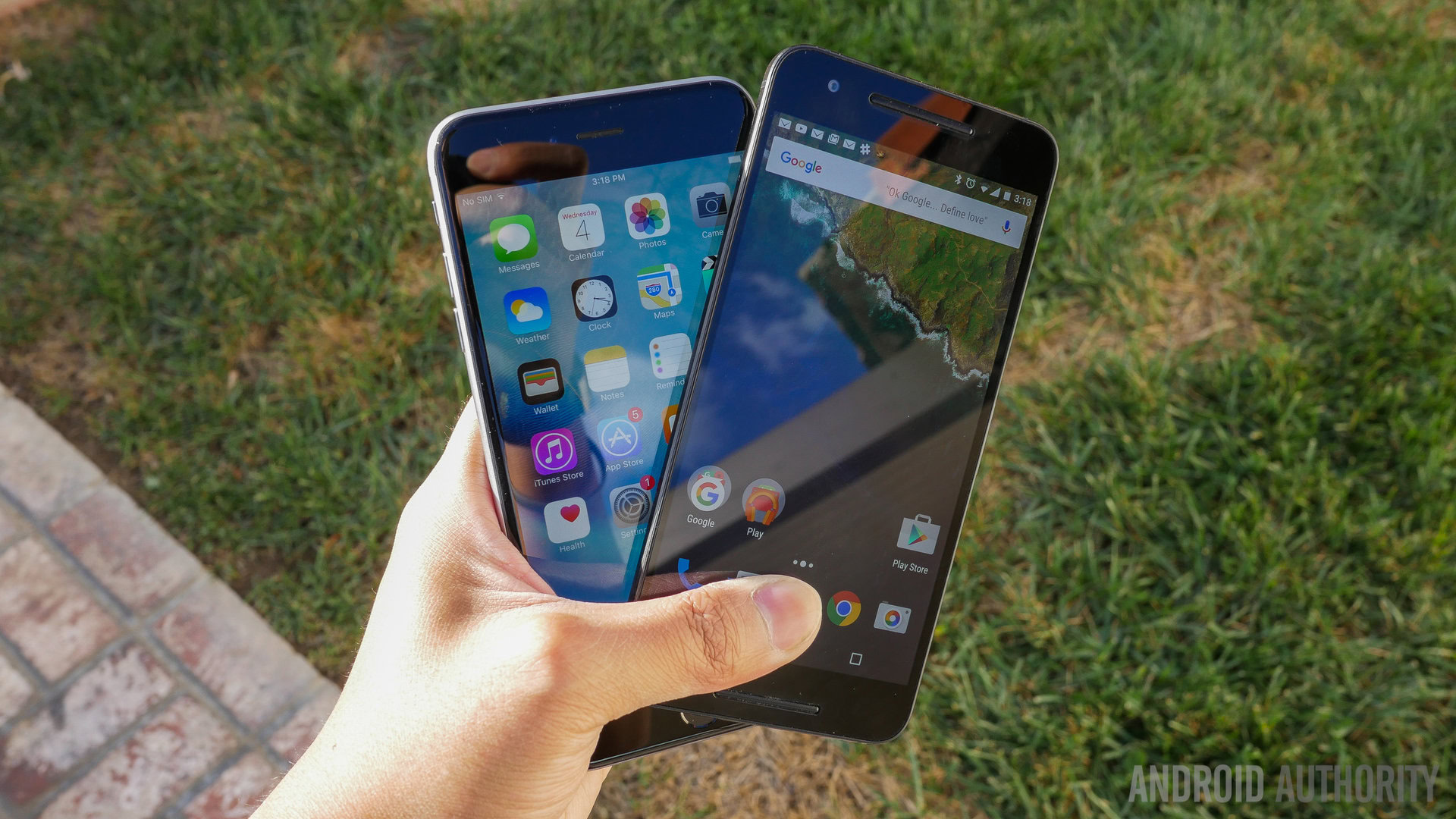
The spec hungry will obviously prefer the Quad HD display, but we know that 1080p is still considered the bare standard, and performs just fine for the vast majority of people. Apple does a good job leveraging the IPS display for good quality viewing, but its Android competitor not only brings a higher resolution, but also an AMOLED construction, that allows for a very enjoyable experience of its own.
Performance
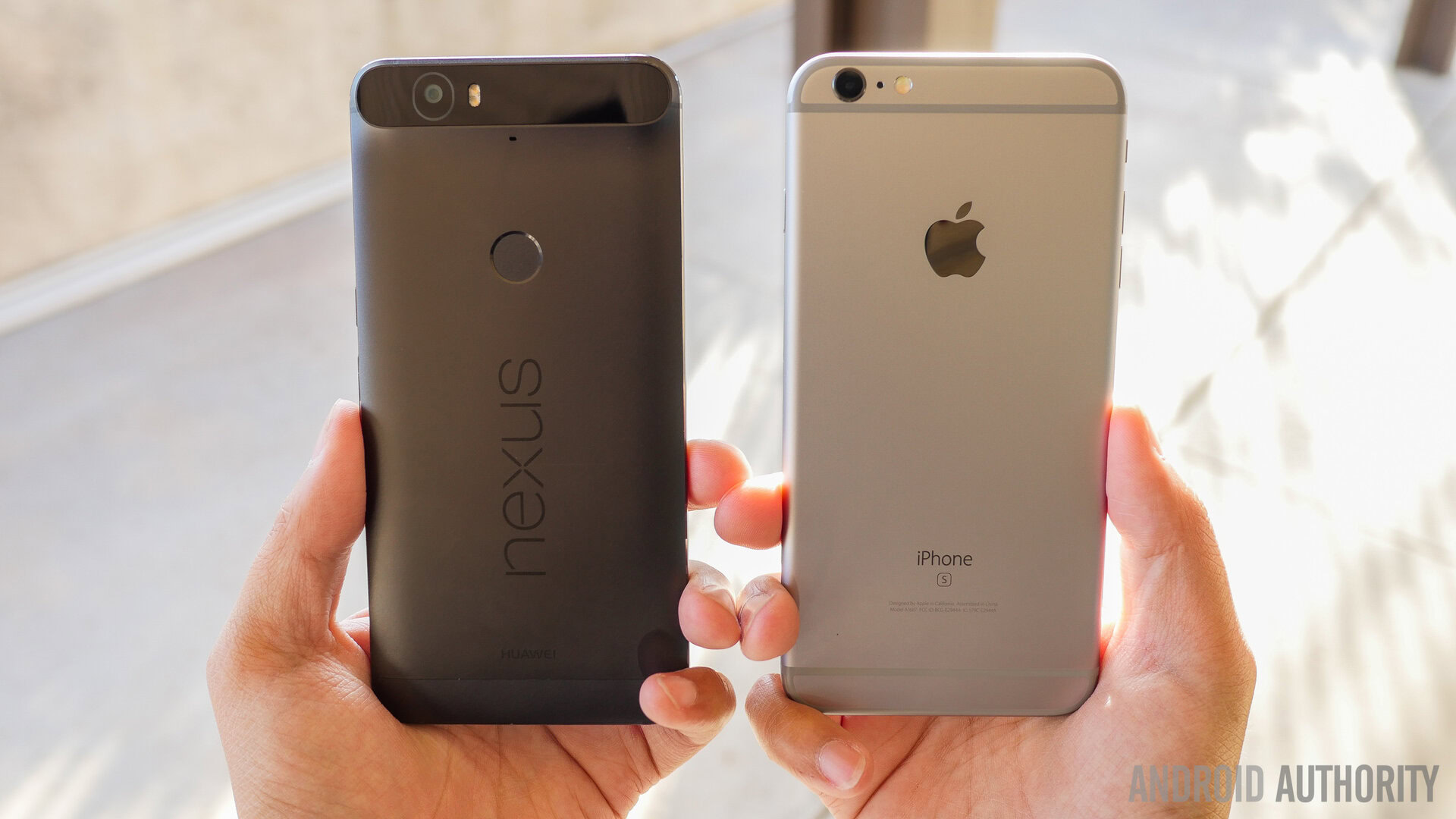
A by-the-numbers comparison is not indicative of performance capabilities here, given the two very different ecosystems these processing packages have to power, but in both cases, we are dealing with the pure version of the respective software experiences, resulting in performances that are as high as it should be.
Apple makes its own processing packages, and the iPhone 6S Plus packs a dual-core Apple A9 processor, clocked at 1.84 GHz and backed by the PowerVR GT7600 GPU and 2 GB of RAM. Android fans will consider this really paltry compared to what dominates in the Android world, but for iOS, this processing package works just fine. Moving in and out of screens and applications is smooth and easy, all applications thus far have run without incident, and the gaming experience remained very good during our testing as well.
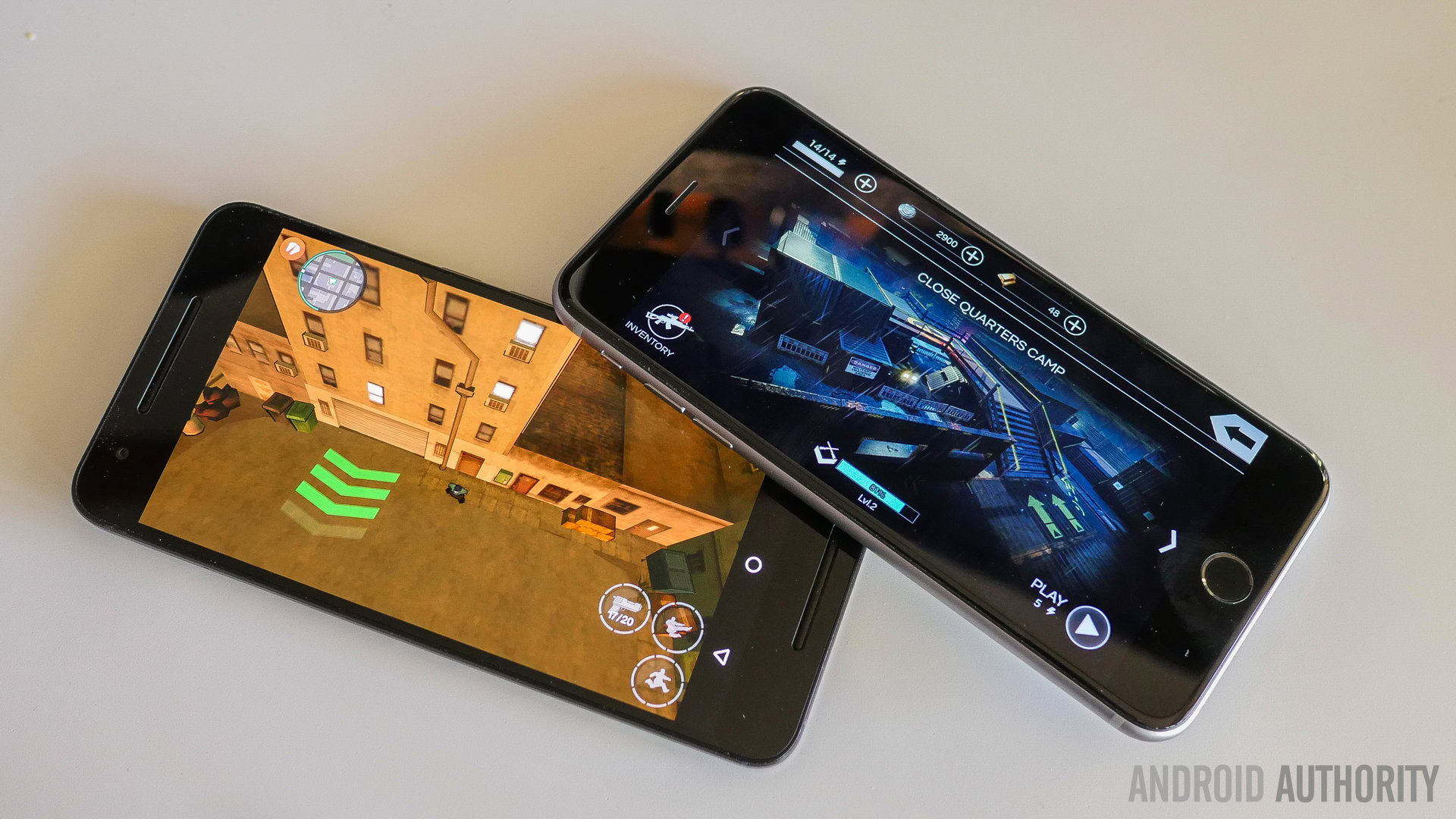
On the other hand, the Nexus 6P comes with an octa-core Qualcomm Snapdragon 810 processor, clocked at 2 GHz, and backed by the Adreno 430 GPU and 3 GB of RAM. This processing package is the current flagship standard, and with the stock software experience to be found on-board, performance is definitely as good as ever. There were no problems getting just about anything done on the Nexus 6P, and gaming has been a wonderful experience as well, further enhanced by the availability of a high resolution display and great sounding front-facing speakers.
All said and done, regardless of which device you may pick, you will certainly not have a difficult time getting things done with these smartphones.
Hardware
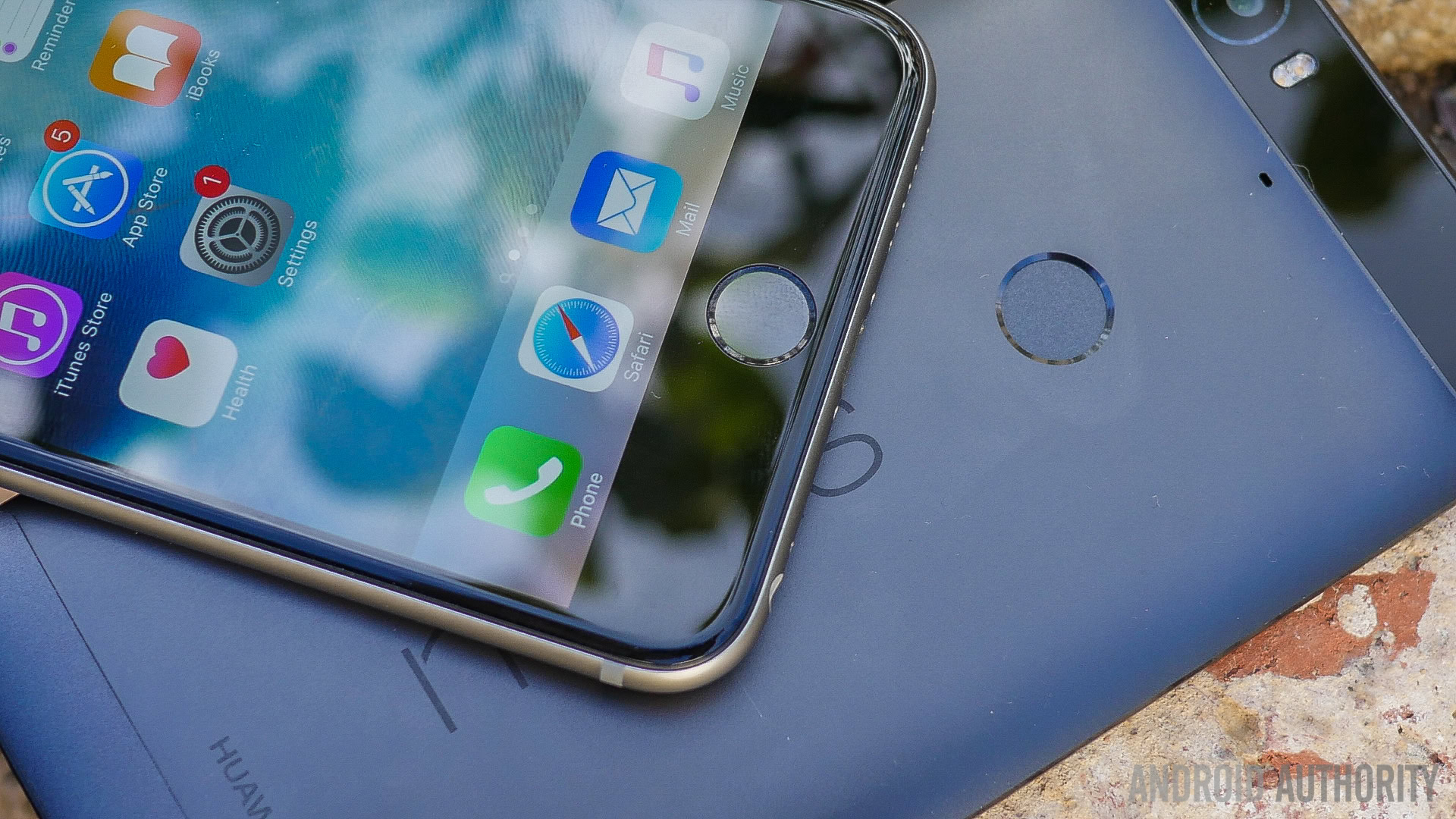
Hardware is one area in which the separation between Android and Apple smartphones has gradually been decreasing, with similar features being added (or omitted) in both cases.
The iPhone 6S Plus brings back the fingerprint reader from previous generations, but in an even faster iteration, so much so that the finger used to press the home button doesn’t even need to rest there to unlock the device. Just the actual press of the button itself is more than enough for the sensor to register a fingerprint. Though there is only a single bottom-mounted speaker to be had, the sound coming from it is actually fairly robust, even if not particularly loud.
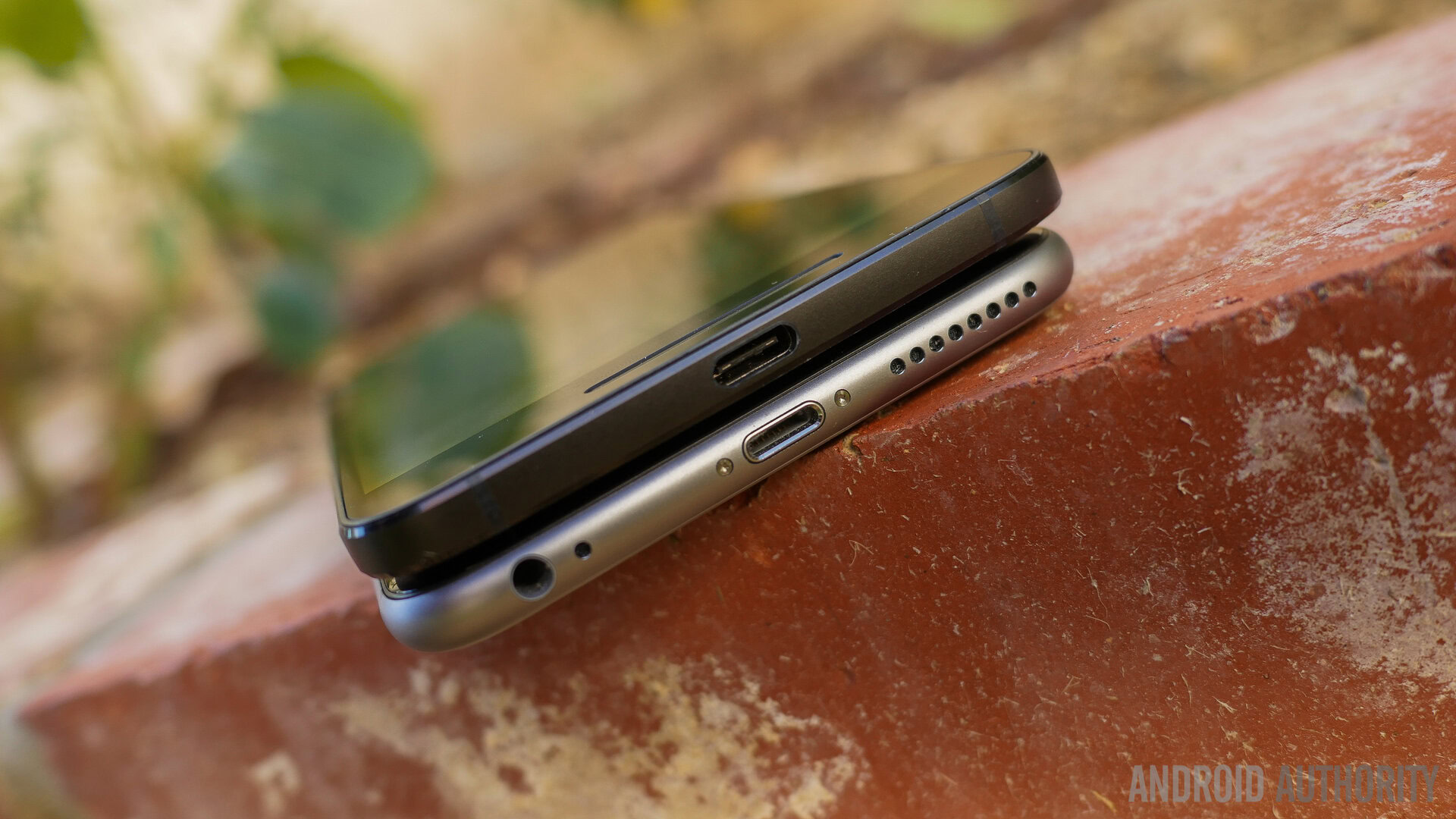
The Lightning port, when it was first introduced, was a pretty big change for plenty of Apple users, and this is a growing pain that Android users will now have to contend with when it comes to USB Type-C. Finally, in battery, the 2,750 mAh unit of the iPhone 6S Plus is large enough to provide only about a day and half in total with low overall usage, though the standby time is impressive on the Apple phones. Also worth mentioning here is the fact that fast charging has yet to come to the Apple world.
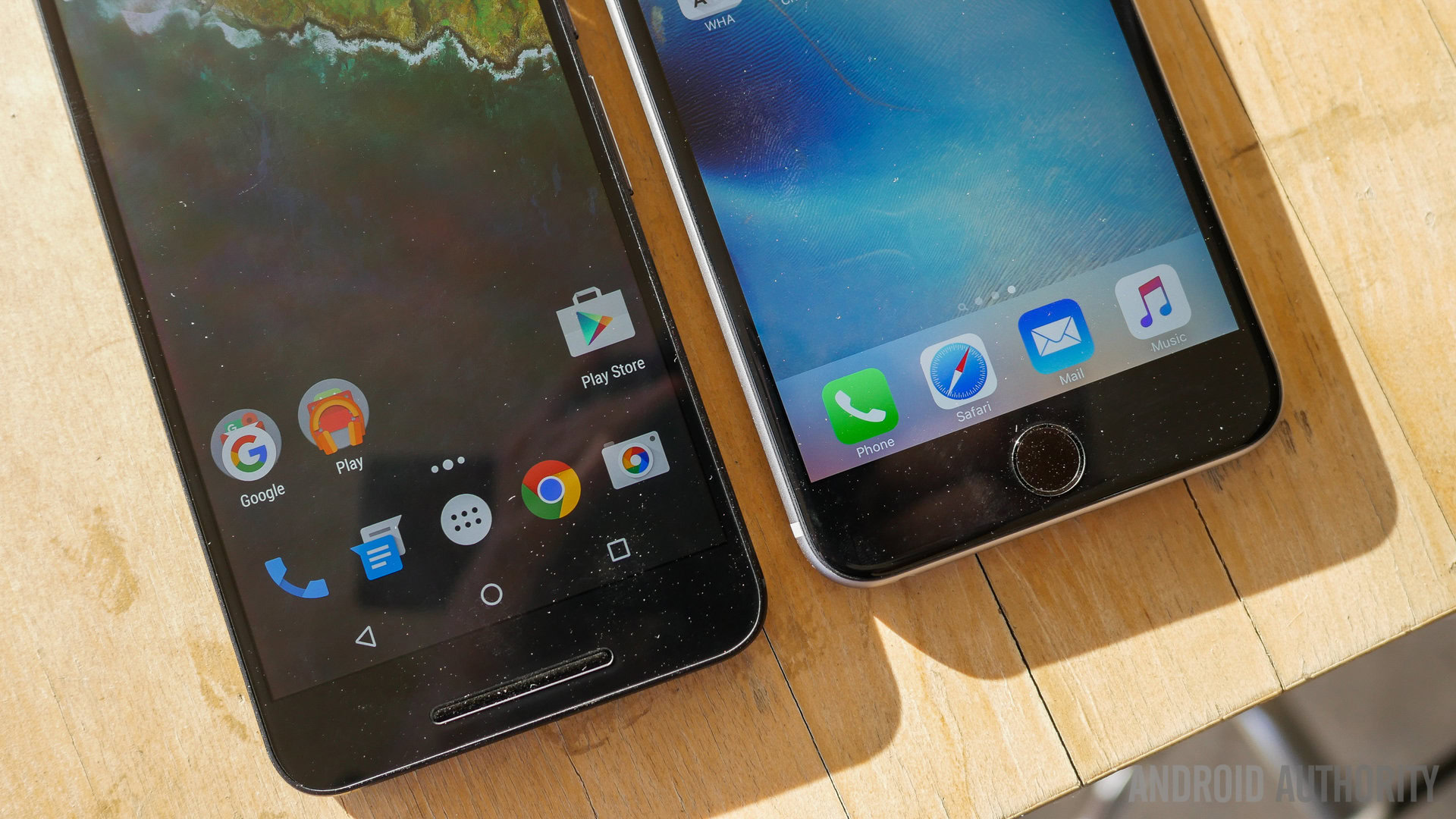
A new hardware addition with the Nexus 6P is the fingerprint reader that is mounted on the back, and is the main point of reference for the new Nexus imprint portion of Android 6.0 Marshmallow. The scanner does work very well, even if it is a little slower than Apple’s, but an index finger on the back wakes the phone and gives you direct access to the homescreens. The Nexus 6P also goes above and beyond with the availability of dual front-facing speakers, that do a great job of bringing pretty loud, full, stereo sound to whatever you are doing, making gaming and media-consumption very fun experiences.

USB Type-C is the new standard for Android, and while it is kind of hard to remember to bring the cord along when heading out, the benefit here is the fast charging, that allows for the large 3,450 mAh battery of the Nexus 6P to fully charge in around 90 minutes. Battery life also benefits from the new Doze feature of Android 6.0 Marshmallow, allowing for standby times that now rival that of the iPhone. It does require the phone to be sitting flat without any sensors being triggered at all, but the bottom line is that, with typical moderate usage, users could get the device to last for as long as 2 days fairly easily.
Simply put, the Nexus 6P is the phone that will appeal to the power user, with its front-facing speakers, reliable fast charging, and big battery that can go the distance. Plenty of users have been able to get power usage of the iPhones, but without these extras, it falls just short, and will definitely need a tether faster than its Android competitor.
Camera
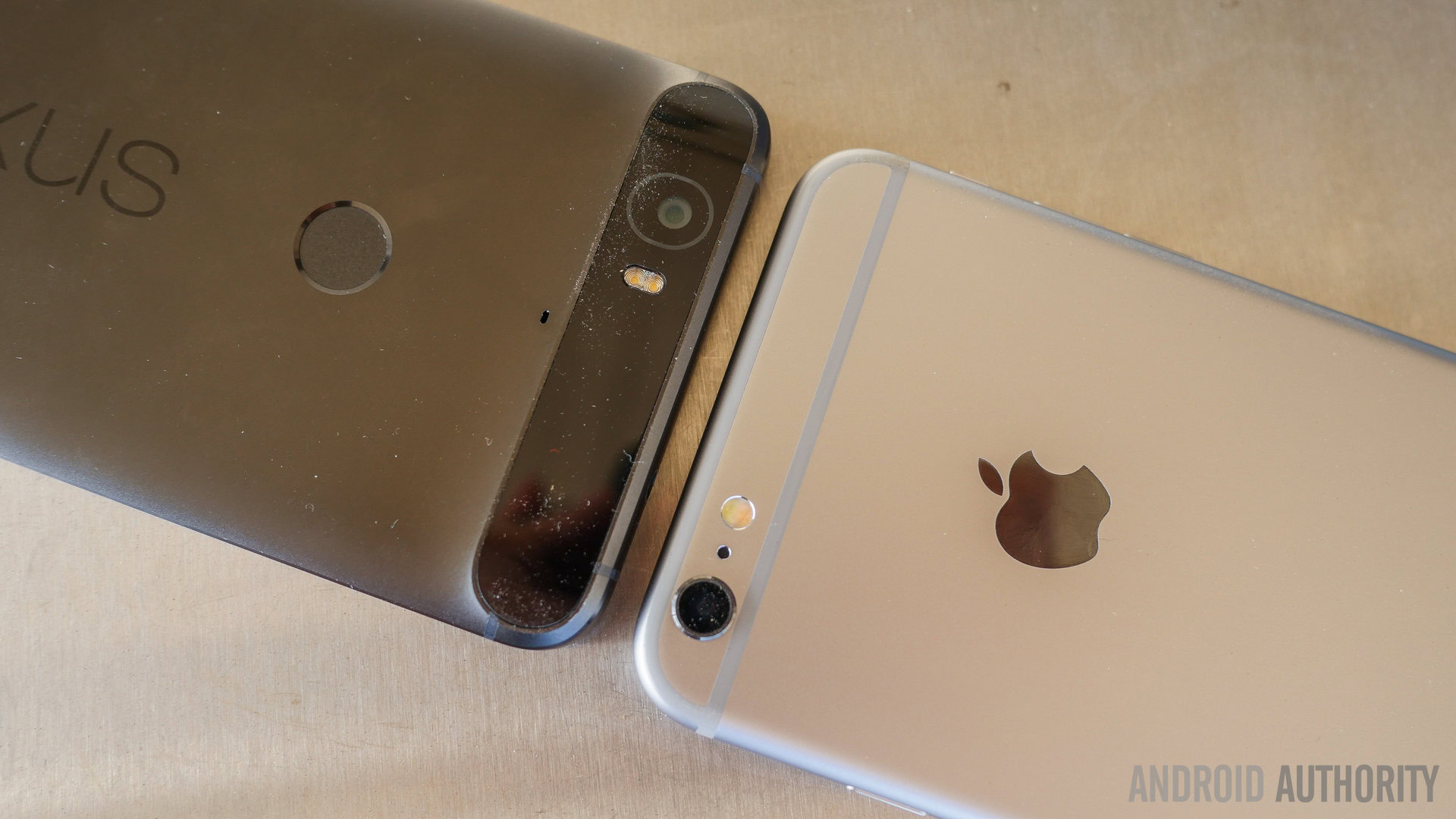
Moving on to the camera, the iPhone 6S Plus features an upgraded 12 MP rear camera with a f/2.2 aperture, along with a 5 MP front-facing unit. The main addition with the rear camera is the ability to record 4K video, which puts it on par with plenty of current generation Android smartphone cameras. Optical image stabilization is also something the iPhone can boast over the Nexus 6P, which surprisingly left it out.
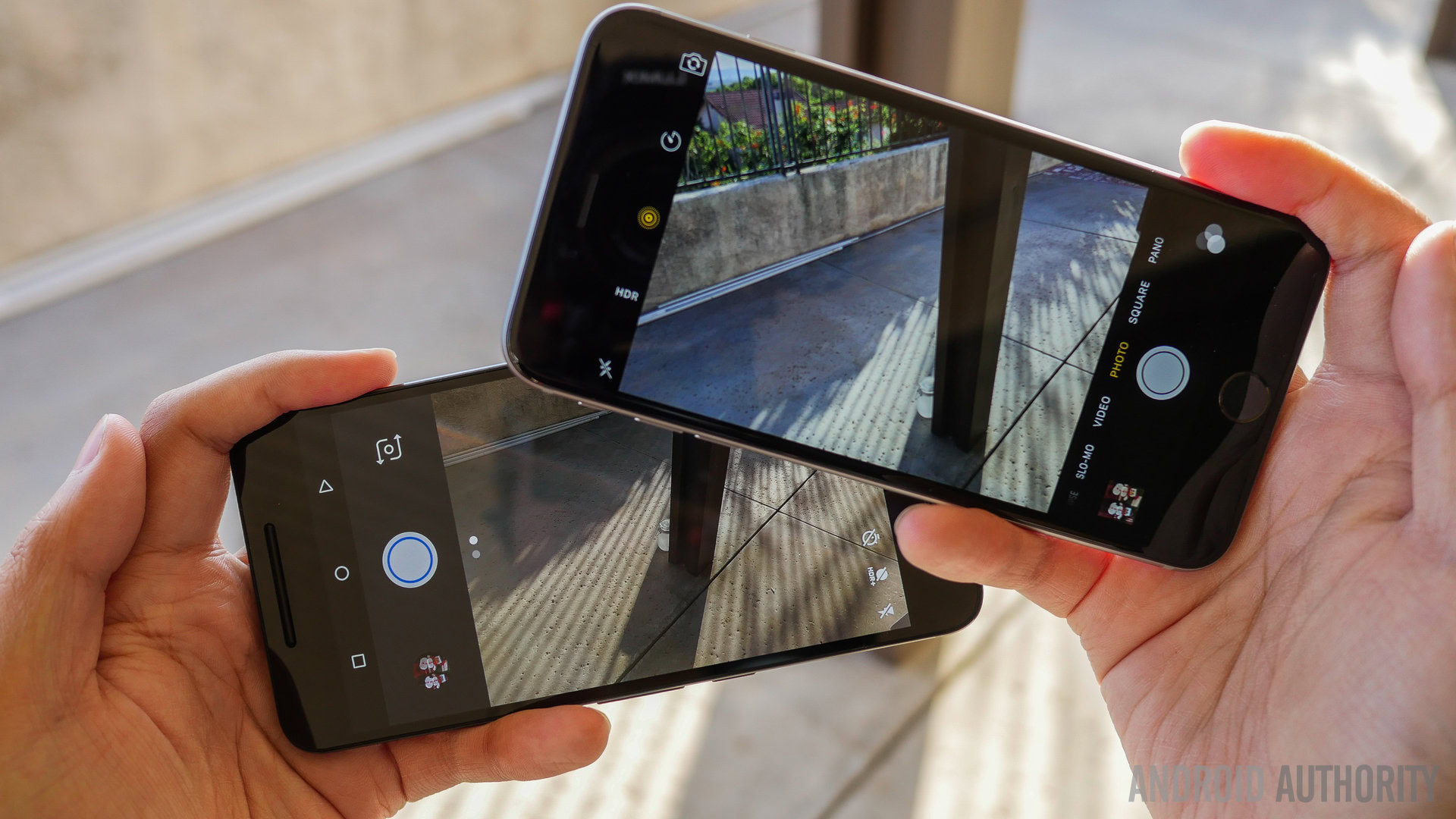
Taking selfies gets an extra feature with a screen-powered flash, and while this does tend to wash out subjects no matter what kind of picture it is, users can at least get some light in really dark situations. As far as the camera application is concerned, the features are fairly robust, but without much manual control. Swiping on the view finder brings up the photo, video, timelapse, and hyperlapse options, but the main focus here is on offering a good default camera interface, and it works pretty well in that regard.
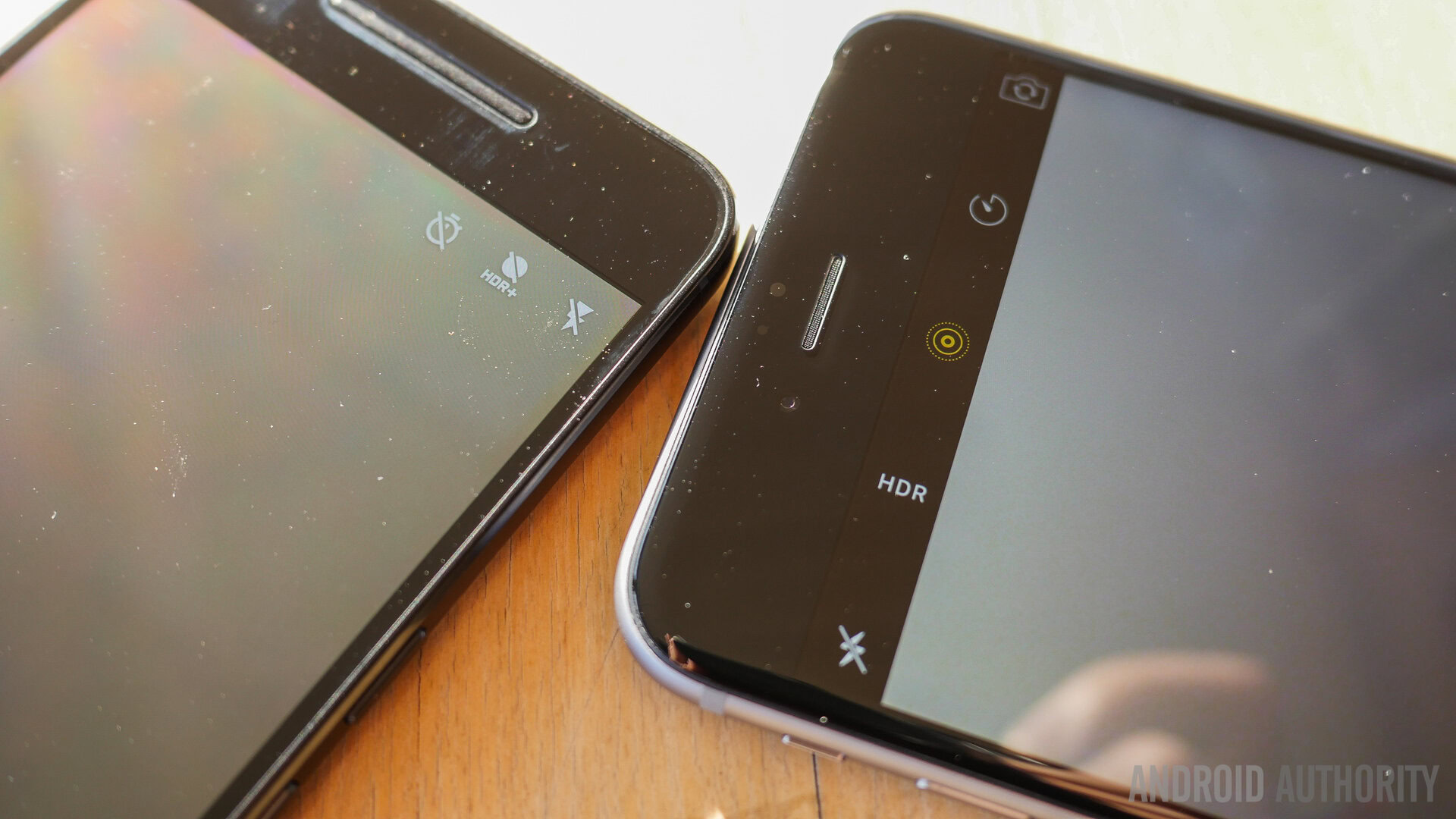
On the other hand, the Nexus 6P also comes with a 12 MP rear camera, which – as Google made sure to tout – has a bigger sensor size than most other Android smartphones, but also the iPhone 6S Plus. OIS is missing here, but the larger sensor should still be able to get in a little more light than typical. The front-facing camera is 8 MP, so pictures will be larger on the 6P than they are on the iPhone, but without a secondary light source, selfies in poorly-lit conditions will be a pain.
Nexus 6P camera samples
Google’s own camera application is also focused on being an automatic shooter, so there aren’t really manual controls to be seen here either. Other than the ability to make HDR+ automatic or not, use Lens blur for a depth of field look, or capture a Photo Sphere, the app is pretty simplistic, and doesn’t come with too many bells and whistles.
iPhone 6S Plus camera samples
Of course, what matters the most here is the quality of the shots possible with these cameras, and in this case, the two phones are on an even playing field. The iPhone family has always been lauded for bringing good camera experiences, and that continues with the iPhone 6S Plus. OIS does a good job of getting in a little more light in poorly-lit conditions, and it does get a bit more than the Nexus. While previous Nexus devices were infamous for their average camera quality, the Nexus 6P marks new territory with a larger sensor, that, even without OIS, does a great job in photos. To that end, we actually found plenty of photos to be a toss-up in terms of detail and visuals.
Software
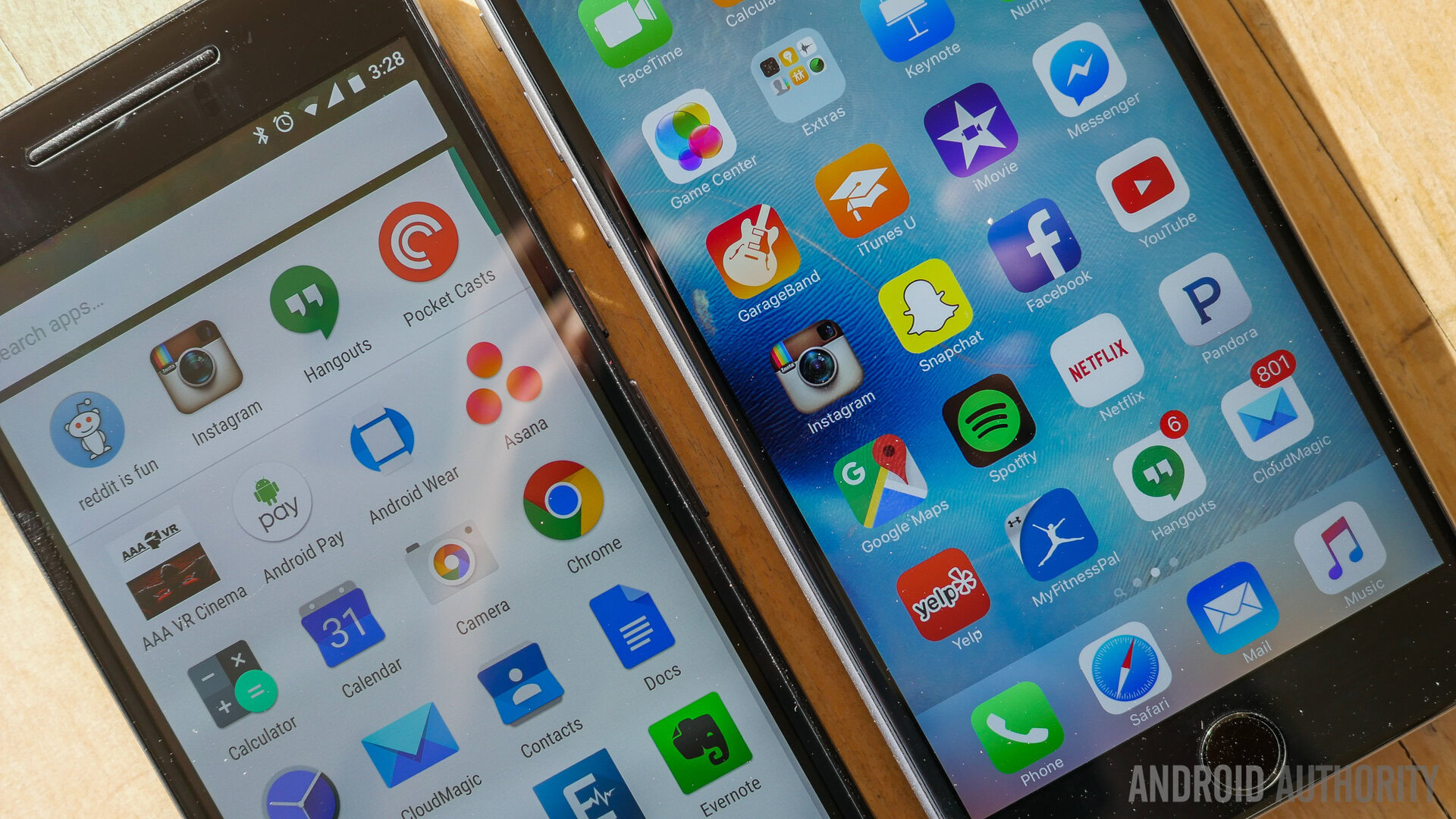
Finally, on the software side of things, we return to the age-old comparison of Android vs iOS, that might have admittedly been much easier to conduct only a couple of years ago.
iOS is still aesthetically about the same as its past few iterations. The homescreens contain all the installed applications, and while widgets are still unavailable, a few additions over the last couple of years have made a difference. The notification dropdown is similar to Android’s original creation, but a secondary screen can bring up a few extra shortcuts and glances at some contextual information, and a swipe up from the bottom opens the Control Center, where a number of controls and toggles are easily accessible.
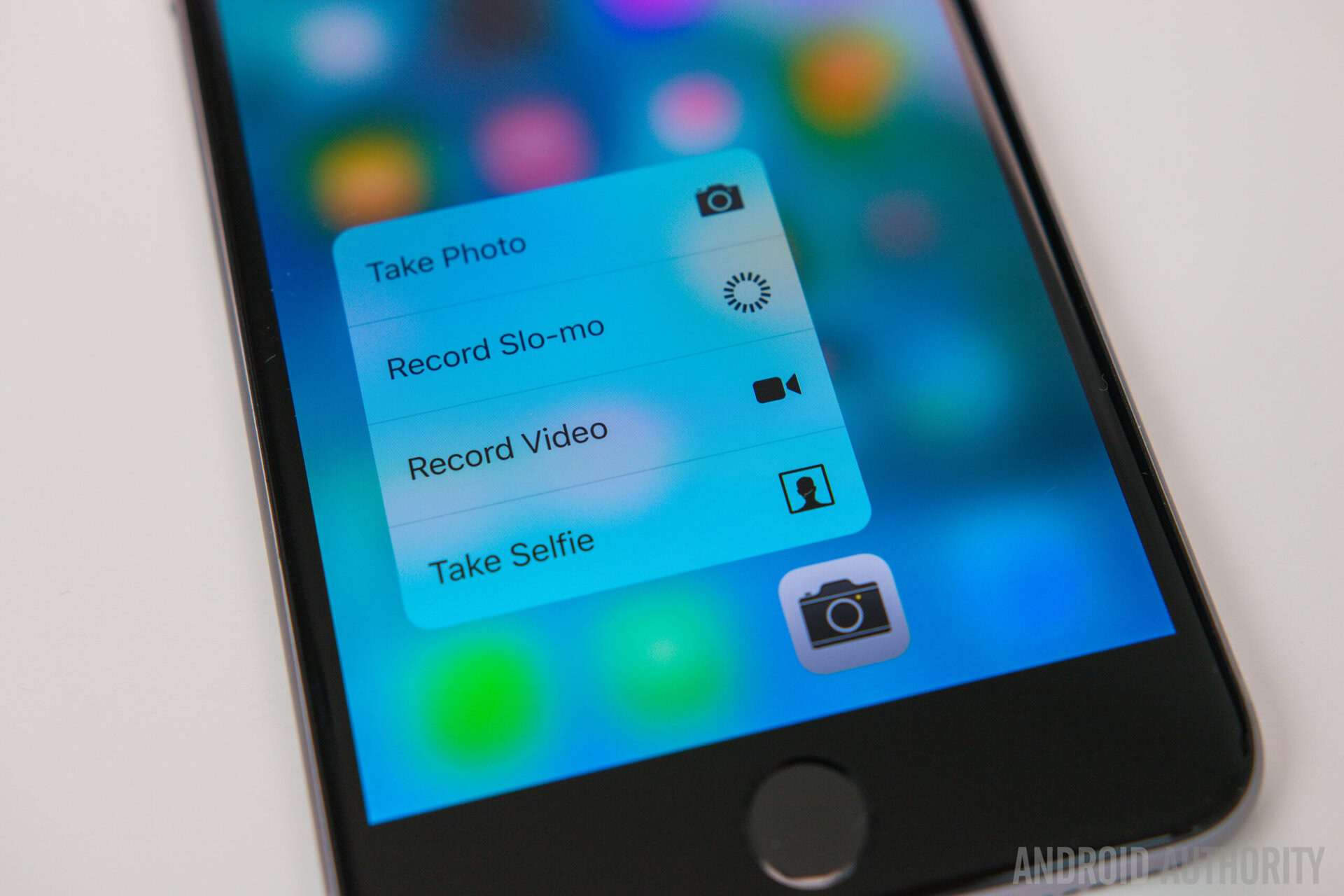
Of course, the biggest addition with the iPhone 6S Plus is 3D Touch, which leverages a layer of sensors underneath the screen to sense any harder than normal presses. By doing so, shortcuts will appear from icons on the homescreens, and previews pop up in various built-in applications. This is a level of input that Apple has effectively added in, and adds a new dimension to what has been a very familiar software experience over the years. Apple’s design prowess permeates through iOS, with all the elements shown in a very smooth and pleasing way. Such is the benefit of a focused, unitary ecosystem, that anyone who gets an iPhone will get this kind of experience without fail.
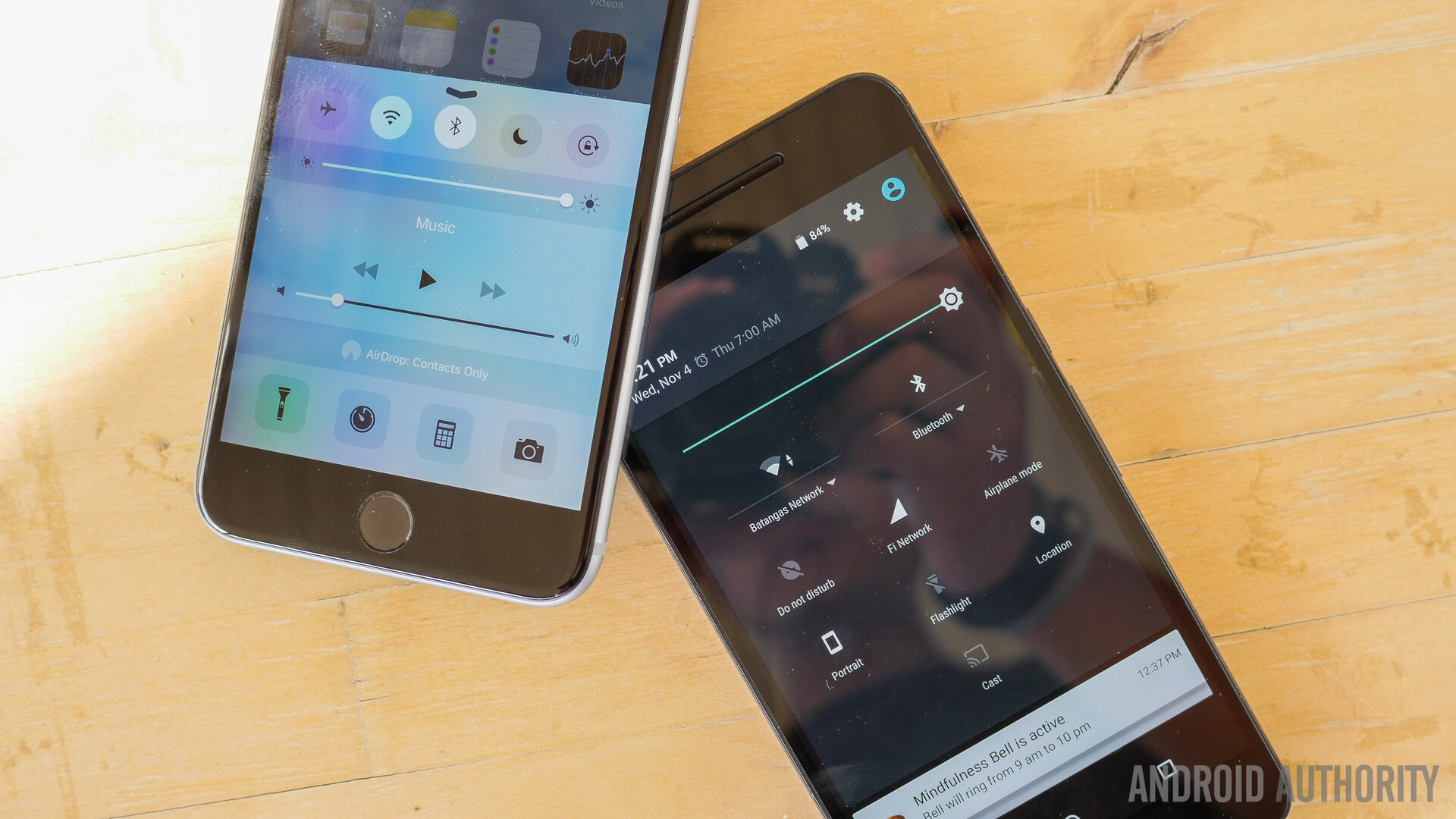
That is also why the Nexus family is so important to Android lovers. If the purest software experience is what you’re looking for, the Nexus is where one will have to go to get it. Android 6.0 Marshmallow is the latest iteration of Android the way that Google wants it to be experienced, and while it is as smooth and snappy as ever, it is also a robust package in and of itself.
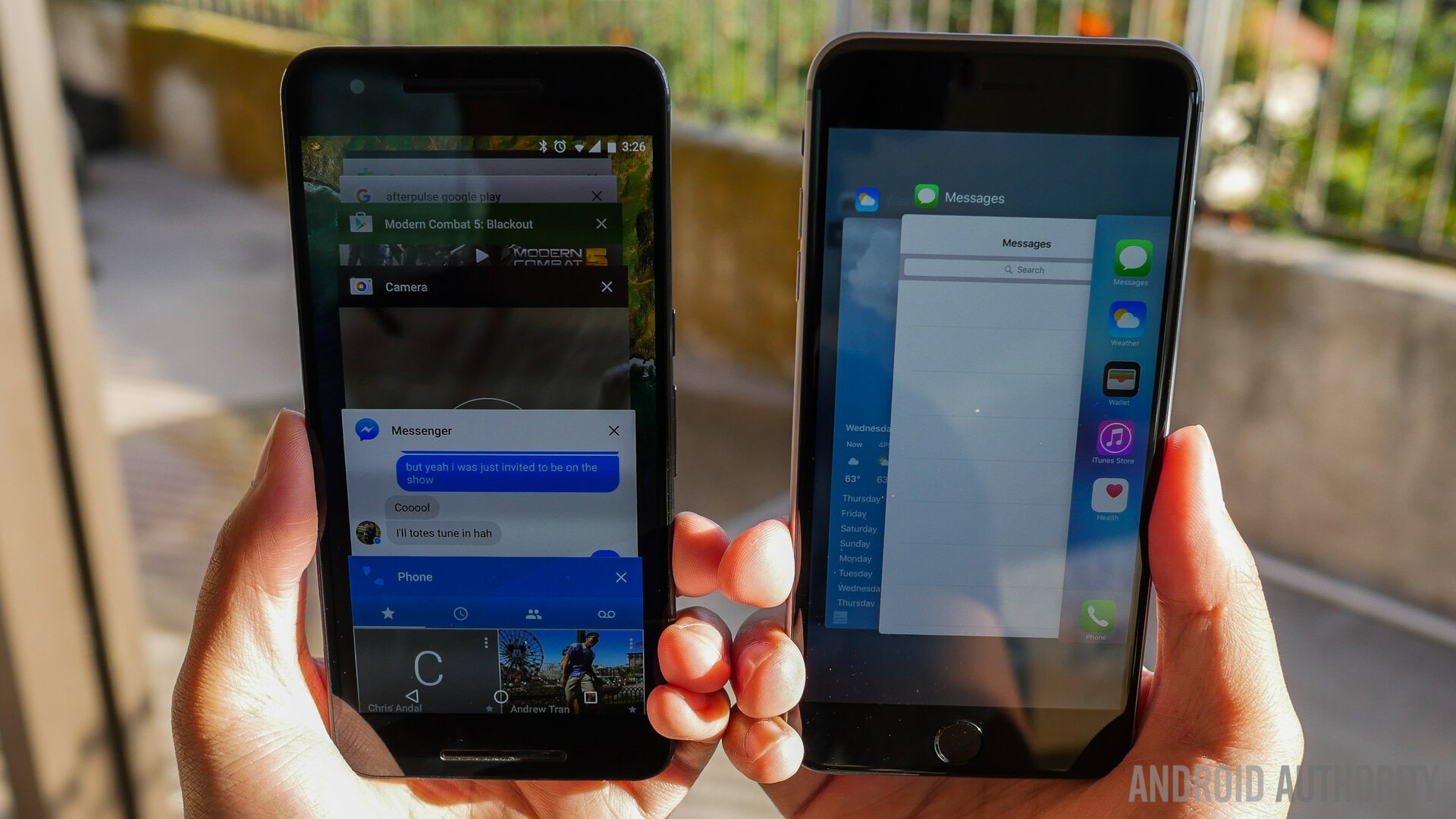
You can, of course, fill up your homescreen with icons, but this being Android, a variety of widgets are available. On the side is Google Now, and the notification dropdown here includes its own version of Quick Settings, so that everything you may need remains within easy reach. Marshmallow has refined some of the well-known aspects, like adding a frequently used apps line in the now vertical scrolling app drawer. App permissions bring a certain level of security to daily tasks, similar to how iOS might constantly notify users that other apps are being triggered or opened, but a whole page for deeper insight is now available too.
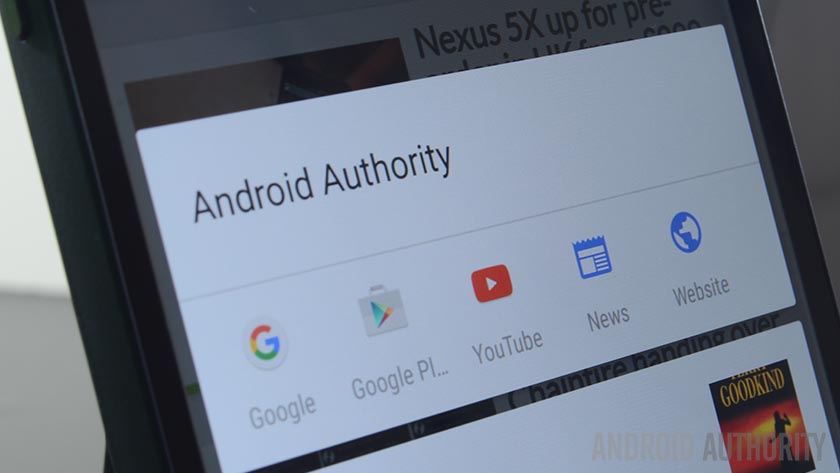
Google Now on Tap is an easy way to quickly do a search based on what is on the screen, though it might seem a little fickle at times. Though Material Design arrived a couple of versions ago, the overall Android experience has been refined, and made not only easier on the eyes, but also easier on workflow. Multi-tasking might be a little bare, but you won’t have any trouble with work or play on this mature operating system.
People that are already entrenched in the Android or iOS camp will have little reason to move to the other ecosystem. In the past, app support for iOS used to be more robust than on Android, but that gap is all but closed.
Specs comparison
| Nexus 6P | iPhone 6s Plus | |
|---|---|---|
Display | Nexus 6P 5.7-inch AMOLED display Quad HD resolution, 518 ppi | iPhone 6s Plus 5.5-inch IPS LCD display Full HD resolution, 401 ppi |
Processor | Nexus 6P 2 GHz octa-core Qualcomm Snapdragon 810 Adreno 430 GPU | iPhone 6s Plus 1.8 GHz dual-core Apple A9 PowerVR GT7600 GPU |
RAM | Nexus 6P 3 GB | iPhone 6s Plus 2 GB |
Storage | Nexus 6P 32/64/128 GB no expansion | iPhone 6s Plus 16/64/128 GB no expansion |
Camera | Nexus 6P 12 MP rear camera, 1.55 micron pixel size, laser auto focus, dual LED flash 8 MP front-facing camera | iPhone 6s Plus 12 MP rear camera with OIS 5 MP front-facing camera |
Connectivity | Nexus 6P Wi-Fi 802.11 a/b/g/n/ac Bluetooth 4.1 GPS + GLONASS NFC USB 2.0, USB Type-C | iPhone 6s Plus a/b/g/n/ac Bluetooth 4.2 GPS + GLONASS NFC ( with Apple Pay only) USB 2.0 |
Software | Nexus 6P Android 6.0 Marshmallow | iPhone 6s Plus iOS 9 |
Battery | Nexus 6P 3,450 mAh | iPhone 6s Plus 2,750 mAh |
Dimensions | Nexus 6P 159.3 x 77.8 x 7.3 mm 178 grams | iPhone 6s Plus 158.2 x 77.9 x 7.3 mm 192 grams |
Gallery
Pricing and final thoughts
Prices for both of these devices reach the premium brackets, but the iPhone is notorious for being a very expensive phone, especially when a higher storage capacity is factored in. $749 total in payments to T-Mobile gets you the 16 GB version, with the 64 GB iteration setting you back and additional $100. On the other hand, the Nexus 6P is more aggressively priced, but given its unlocked nature, requires a full payment. $499 will get you the base model, requiring another $50 for the 64 GB edition.
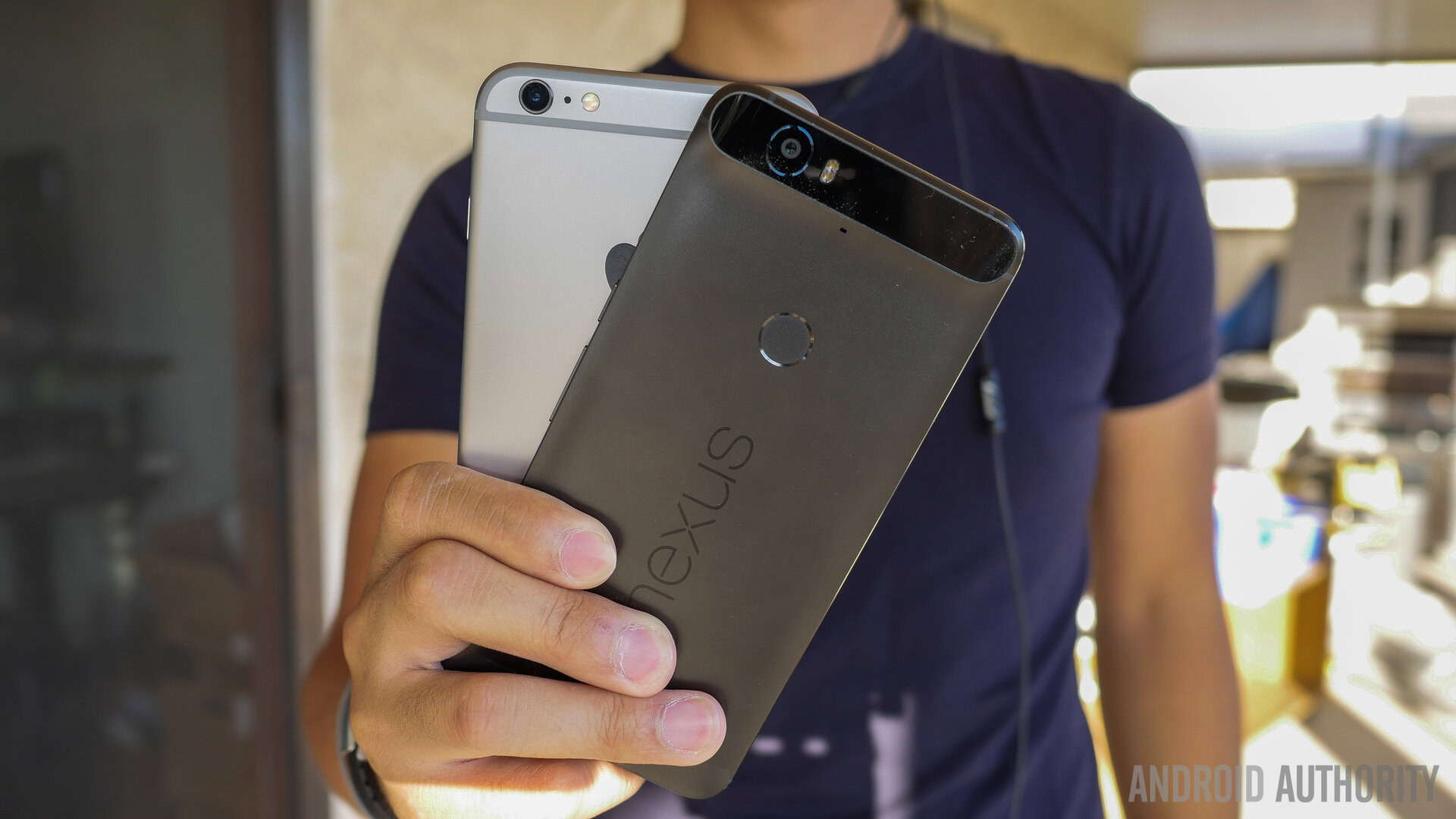
So there you have it for this in-depth look at the Nexus 6P vs iPhone 6S Plus! These are the bigger quintessential devices of their respective lines, and they both certainly bring a lot to the table. Apple jumped into the large form factor game only last year, and with the 6S Plus, it is more about refining the formula, aside from the one main addition in 3D Touch. The Nexus 6P is Google’s latest attempt to not only provide a great reference point, but rather be a device that is worthy of claiming the flagship crown. With a design overhaul, Marshmallow additions, and an improved camera, it is worthy of being considered as such.
If you want a larger display with performance to match, either of these devices will do. Purists will stick to what they know and love, and in this comparison, we see that the grass is greener on the other side, in either case.